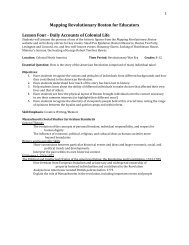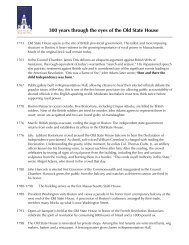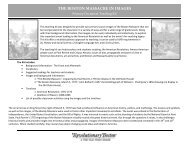Sweet History: Dorchester and the Chocolate ... - Bostonian Society
Sweet History: Dorchester and the Chocolate ... - Bostonian Society
Sweet History: Dorchester and the Chocolate ... - Bostonian Society
Create successful ePaper yourself
Turn your PDF publications into a flip-book with our unique Google optimized e-Paper software.
SWEET HISTORY: <strong>Dorchester</strong> <strong>and</strong> <strong>the</strong> <strong>Chocolate</strong> Factorywww.bostonhistory.org/bakerschocolate/use of powered machinery began, not in Europe, but in <strong>the</strong> American colonies, after NewEngl<strong>and</strong> began trading cacao from <strong>the</strong> West Indies in <strong>the</strong> 1750s. The earliest knownmachine-powered chocolate producers were Obadiah Brown of Providence, Rhode Isl<strong>and</strong>,in 1752 <strong>and</strong> John Hannon of Milton, Massachusetts, in 1765. Water-powered mills wereable to mass-produce chocolate at a much faster pace <strong>and</strong> in greater quantities. Thisearly industrialization dramatically reduced <strong>the</strong> cost of <strong>the</strong> final product <strong>and</strong> chocolatebecame affordable to <strong>the</strong> general public. 122The world continues to consume great quantities of chocolate. Statistics calculated in2002 average <strong>the</strong> world’s yearly chocolate intake of approximately 1.2 pounds per person.The average European consumes just over four pounds per year. The Americas come insecond at 2.6 pounds per person, with Africa at a third of a pound, <strong>the</strong>n Asia <strong>and</strong> <strong>the</strong>Pacific isl<strong>and</strong>s at just under a quarter pound per year. 123Today’s Cacao Producing RegionsToday cacao is grown in <strong>the</strong> Ivory Coast, Ghana, <strong>and</strong> Indonesia, with Nigeria <strong>and</strong> Brazilrounding out <strong>the</strong> top five countries. Many of <strong>the</strong> cacao regions established centuries agostill grow <strong>the</strong> beans today, along with dozens of new regions located along <strong>the</strong> equator.The Ne<strong>the</strong>rl<strong>and</strong>s, <strong>the</strong> United States, Ivory Coast, Brazil, <strong>and</strong> Germany are <strong>the</strong> top fiveimporters of cacao beans. 124Harvesting CacaoWhen <strong>the</strong> cacao pods are ready for harvest, <strong>the</strong>y are taken from <strong>the</strong> trees, opened,washed, <strong>and</strong> collected for fermentation. This process turns <strong>the</strong> beans a rich, brown color<strong>and</strong> gives <strong>the</strong> beans <strong>the</strong>ir chocolate flavor. After fermentation, <strong>the</strong> beans must dry toremove moisture for shipping. 125Preparing CacaoWhen <strong>the</strong> manufacturer receives <strong>the</strong> cacao beans, <strong>the</strong>y must be cleaned before roastingbegins. In modern chocolate production, machines help to remove dust <strong>and</strong> debris thatmay have attached to <strong>the</strong> beans during fermentation or shipping. This is also <strong>the</strong> time122The Field Museum, “<strong>Chocolate</strong>: A Contemporary Confection-1750-1910,” <strong>Chocolate</strong>: The Exhibition,2002 [online]; available from http://www.fieldmuseum.org/chocolate/history_contemp2.html; Internet, accessed 25October 2005; Hedges, The Browns of Providence, 8-9.123International Cocoa Organization, ”World Cocoa Consumption,” International Cocoa Organization,September 2003 [online]; available from http://www.icco.org/questions/world.htm; Internet, accessed 1 November2005.124International Cocoa Organization, ”Main Cocoa Producing Countries <strong>and</strong> Their Cocoa Bean Production,”International Cocoa Organization, September 2003 [online]; available from http://www.icco.org/questions/production.htm; Internet, accessed 25 October 2005; International Cocoa Organization, ”Main Cocoa Grinding Countries <strong>and</strong>Their Grindings of Cocoa Beans,” International Cocoa Organization, September 2003 [online]; available fromhttp://www.icco.org/questions/grindings.htm; Internet, accessed 25 October 2005;125The Field Museum, “Harvesting Cacao,” <strong>Chocolate</strong>: The Exhibition, 2002 [online]; available fromhttp://www. fieldmuseum.org/chocolate/making_harvest.html; Internet, accessed 10 June 2005; Charles S. Telly,“<strong>Chocolate</strong>–Its Quality <strong>and</strong> Flavor (Which is <strong>the</strong> World’s Best <strong>Chocolate</strong>?),” <strong>Chocolate</strong>: Food of <strong>the</strong> Gods, ed. AlexSzogyi (Westport, Conn.: Greewood Press, 1997) 168-168.38 of 76© 2005 The <strong>Bostonian</strong> <strong>Society</strong>. Nothing from <strong>the</strong> site can be reproduced without specific written permission issued by:The <strong>Bostonian</strong> <strong>Society</strong> • 206 Washington Street • Boston, MA 02109-1773. Any questions, call 617-720-1713.






